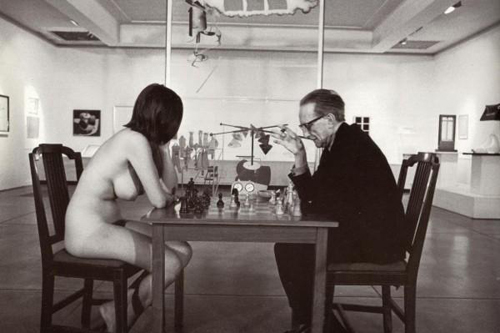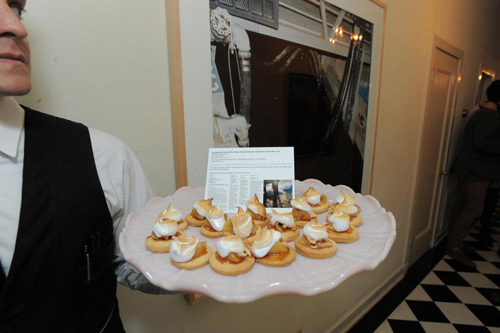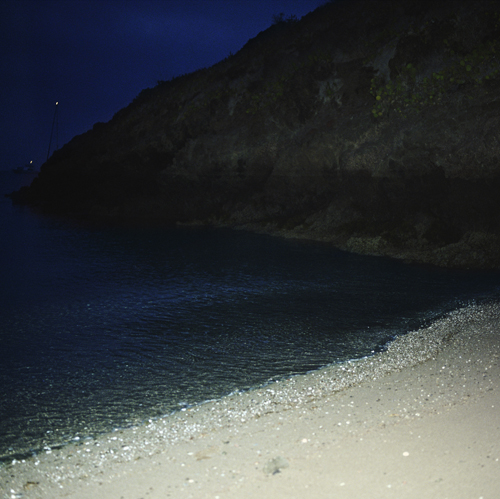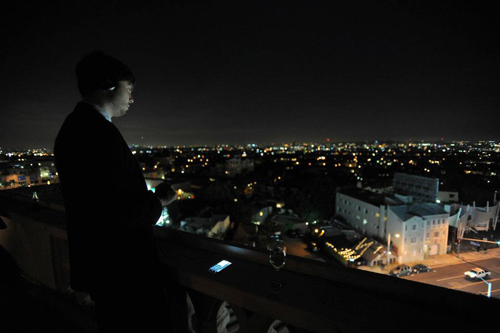
Eve Babitz and Marcel Duchamp playing chess at the Pasadena Art Museum, October 18, 1963. Photo by Julian Wasser.
Eve Babitz first came into my life via an Amazon book transaction. I had purchased the out-of-print Marcel Duchamp study, West Coast Duchamp, for the amazing price of $6.99. It later turned out that the seller had accidentally left out a digit—the price should have been $64.99. But she was good-humored about it, and let me have the book anyway.
Tucked into the back of the book was a faded Xerox copy of plate no. 34—the legendary photograph you see above of Eve playing chess nude with Marcel Duchamp, as part of the opening reception for his landmark Pasadena Art Museum retrospective. I don’t know why it was there—apparently the previous owner had taken a special interest in the chess match, and perhaps he or she had wanted to share it with others.
I didn’t think about Eve again until she started to snake her way back into L.A.’s public consciousness via the resuscitative festivities of Pacific Standard Time. Hunter Drohojowska-Philp, who came out with the historic tell-all book Rebels in Paradise last year, claimed that Eve’s writing had enabled her to find the right tone to use in her own book. In August of 2011, she corralled the acclaimed writer and storied ex-groupie into giving a talk with her at the Hammer, which generated quite a bit of buzz and brought out legions of people who had been devoted fans of Eve for years. The talk, which is thankfully archived on the Hammer website, is a gem, filled with great stories, witticisms, and Eve’s effervescent personality.
On May 3, 2012, artist Zoe Crosher held something of a conceptual séance for Eve, attempting to bring her out into the public again with an event called For an Evening with Eve Babitz. Done under the auspices of Los Angeles Nomadic Division’s Nomadic Nights, an ongoing series of pop-up art events, For an Evening with Eve Babitz was held in the penthouse suite of the Chateau Marmont hotel, the beloved site of many of Eve’s adventures back in the day.

A waiter serves up "pate bois" in front of Zoe Crosher's Transgressing the Pacific: Where Dennis Wilson Disappeared in Marina del Rey, Fujiflex archive print, 2008. Photo by Jordan Strauss/WireImage, courtesy of Los Angeles Nomadic Division (LAND).
Throughout the suite, Crosher installed photographs from her Transgressions series, which depict places throughout Los Angeles where famous figures, both real and fictional, disappeared. The haunting shoreline of Catalina Island near where Natalie Wood plunged to her mysterious death is included, along with the pylons at the Venice Pier where Michael Douglas’ fictional character jumped in the movie Falling Down. Adding another evocative layer to the experience, Crosher collaborated with chefs Caitlin Williams Freeman and Mariah Swan to create special desserts whose ingredients were inspired by the qualities and stories contained in the photographs.
The most intriguing concoction, which I sadly did not get to sample, was the salted fennel and orange cotton candy, made to go with the image of Ocean Beach where charismatic church leader Aimee Semple McPherson had purportedly been kidnapped in 1926. It was inspired by the white fluff of sea foam, and oranges and fennel harvested near her church in Echo Park. I imagine the way cotton candy literally disappears in your mouth, leaving behind the exotic taste of fennel and orange, would have been a perfect evocation of the theme at hand.

Zoe Crosher, Transgressing the Pacific: Where Natalie Wood Disappeared Off Catalina Island, Fujiflex archive print, 2008. Courtesy of the artist and Perry Rubenstein Gallery, Los Angeles. © Zoe Crosher.
Disappearance was everywhere in that hotel suite. The missing persons, the melting confections, the seedy excitement of years gone by, the three blown out letters in the hotel’s marquee that turned it into the “Chat Marmont.” So it is perhaps fitting that Eve herself, who had been invited as the guest of honor, was a no show, telling the organizers that she no longer goes out at night. She may, however, resurface for lunch with Crosher at a later date.
In the meantime, the artist told me that while it would have been fantastic to have Eve at the event, her most urgent goal was actually to get all of Eve’s books back in print. While most of them are available online as used books, the most iconic ones—Eve’s Hollywood and Slow Days, Fast Company: The World, the Flesh, and L.A.—are sold at premium prices. Like many people, Crosher is a passionate fan of Eve’s writing, probably feeling as I do that no one else is quite as capable of capturing the random, elusive, contradictory, in-and-out poetry that is life in Los Angeles, then as now. It is lamentable that her books have fallen into such neglect, though also typical of the laissez-faire laziness of L.A.—a quality that Eve herself has often discussed.

A guest listens to recordings of Zoe Crosher reading texts by and about Eve Babitz, at the Chateau Marmont hotel in West Hollywood. Photo by Jordan Strauss/WireImage, courtesy of LAND.
The final element of For an Evening with Eve Babitz was a set of recordings that guests could listen to with headsets. On it, Crosher reads selections from Slow Days, Fast Company; an oral history interview with Eve conducted by the Smithsonian in 2000; and a thoughtful essay by journalist Steffie Nelson. The first ten minutes or so of the Slow Days, Fast Company reading are as uncanny an invocation of Los Angeles as has ever been written, and a beautiful coda to this nostalgic evening on the Sunset Strip. I listened to it while sipping on a White Lady, a bewitching cocktail of gin, cointreau and egg white that was Eve’s favorite.
“No one likes to be confronted with a bunch of disparate details that god only knows what they mean. I can’t get a thread to go through to the end and make a straightforward novel. I can’t keep everything in my lap, or stop rising flurries of sudden blind meaning. But perhaps if the details are all put together, a certain pulse and sense of place will emerge, and the integrity of empty space, with occasional figures in the landscape, can be understood at leisure, and in full, no matter how fast the company.”



